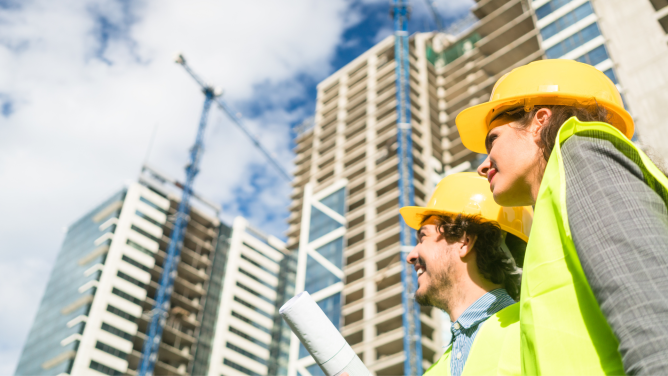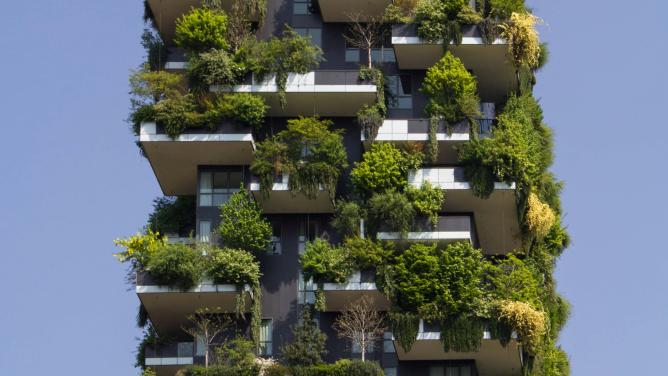When renovation rivals new-builds
The world of construction is traditionally dominated by new-builds. The entire sector is summed up in one unequivocal term, that of “construction.” This hegemony is now challenged by a range of factors. The sector accounts for 39% of CO2 emissions worldwide and is looking to reduce its impact. The stress on resources is prompting the amount of new-builds to be limited, and policies aiming to curb artificialisation are set to become more widespread (in the wake of the ZAN – or zero net artificialization objective in France). These pressing needs aim to normalise a whole new vocabulary for construction stakeholders: renovation, refurbishment, reversibility and circularity are no longer niche topics. These are now the focus of conversation – just take the 6th edition of the Building Beyond Festival, organised by Leonard from 19-24 June, which puts “the future of what’s already existing” at the centre of the debate. These terms are also at the centre of practices: for the first time in the US, building permits for renovations have overtaken those for new-builds in 2022.

A major environmental issue
The main argument in favour of renovation concerns its intrinsically environmental dimension. ADEME explains that building a new detached house consumes 40 times more materials than a BBC renovation (bâtiment basse consommation, or low energy-consumption building), and in the case of apartment blocks this multiplier increases to 80! Renovation also helps avoid a significant number of construction-related emissions, while boosting the existing building’s energy performance. The IEA estimates that at least 20% of the existing building stock will need to be renovated by 2030 to reach the Net Zero by 2050 goal. The institution sets out the extent of the challenge by highlighting that 40% of the surfaces built in the most developed countries were built before 1980 – the year in which the first energy performance standards entered into force. As such, the public authorities are trying to mobilise. For example, the Renovation Wave programme, which is part of the European Green Deal, plans to double the annual renovation rates (currently estimated at 1% per year) across the continent.
A sector in need of a transformation
Today, the construction industry remains structured around new-builds. In this context, the idea of making renovation projects and urban circularity more widespread and the norm still come up against the issue of skills. A real skills gap has been identified in Europe, which has already led to the creation of BUILD UP Skills. This initiative aims to promote the development of skills related to energy efficiency and the use of renewable energy sources, the use of new materials, the various environmental certification processes, and the use of BIM to maximise the efforts of sustainable energy skills. It has been applied to projects such as TRAINEE in North Macedonia, CraftEdu in the Czech Republic and Slovakia, and HP4ALL, all of which aim to promote the development of skills aligned with the objectives to reduce emissions. The academic world is also looking to refine its courses offered. Through the practical research school ASSURE (Adaptation of Urban Space through Sustainable Regeneration), the Universities of Malmö, Uppsala and Lund in Sweden aim to develop new knowledge about “sustainable renovation and conversion of buildings and neighborhoods.” Finally, we’re also seeing an increase in private initiatives to support the transition. Previously incubated at Leonard, La Solive offers energy renovation training with an emphasis on looking for a career change.
“We have all the technical solutions to refurbish existing constructions. We don’t always have the skilled workers to make this happen, because the construction industry has been extremely driven by new-builds. Renovations don’t require the same skills. It is extremely important to train craftsmen in how to renovate existing building stock. This is very clearly the main priority for this century, because demand is going to be more and more pressing.”
Philippe Madec, architect, urban planner, pioneer of eco-responsibility.
Renovation innovation
In terms of techniques and innovation, most solutions are already on the market. In 2022, the Buildings Performance Institute Europe (BPIE) published a study on the contribution of prefabrication for renovation, highlighting the considerable savings in time and efficiency made possible through process standardisation. There is an abundance of innovation surrounding energy retrofitting, which involves upgrading an old building’s energy properties. New insulation materials – such as smart coatings – display high performance while remaining discreet. Old materials, such as straw and poured earth, are very effective while reducing the carbon footprint of a renovation project. Circular construction also has a myriad of technical solutions up its sleeve. The most emblematic is undoubtedly BIM, which is used to control more precisely a building’s entire lifecycle, right up to the demolition phase. The “urban mine“ concept, which consists of making an inventory of the materials already present in a city in order to reuse them, can be used to reveal hidden resources in a given area. (A conference will be dedicated to this topic during the Building Beyond festival.)
“The work we’re doing with Paris city hall on the Jean Quarré multimedia library is being talked about because we’ve managed to go all out when demonstrating what renovation means today, in that we have truly accomplished eco-responsibility. We’re renovating a concrete building, but all additional materials are bio-based or geo-based, like wood or poured earth. It’s important to demonstrate that this type of renovation is possible and that we shouldn’t wait to do it.”
Philippe Madec
New-builds and renovation are often presented as rivals, when in reality they’re pretty complementary. Both can represent the most appropriate solution depending on the context of life and use of each building. In an interview with Leonard, Philippe Madec explains that the answer must be related to the context. “When there are population movements across a given territory, linked to heat waves, epidemics, or the difficulties of living in huge cities, these territories are not always ready and prepared to welcome the migrating populations. So yes, construction needs to be reduced, but it has to be done intelligently depending on the situation. Deciding whether or not to build should not be made purely speculatively – as is too often the case today – but must respond to the real needs and aspirations of the populations.”



